Cracking the Code of the Great Sphinx and the Khafre Pyramid
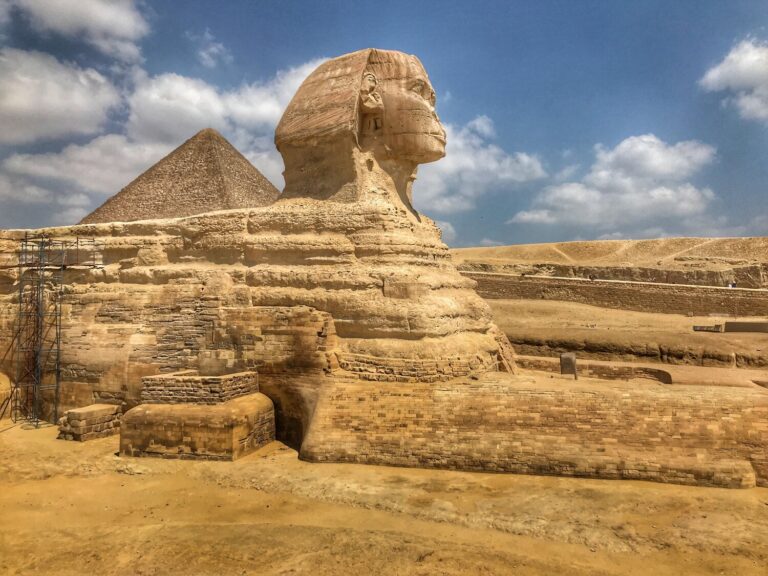
Whose head is that on the Sphinx? The site is crowded with limited access. Still, one of Ancient Egypt’s oldest monuments should be paired with the Pyramids of Giza near Cairo.

Riddle me this: What’s it like visiting the Great Sphinx of Giza?
While many of the ancient sites of Egypt have had their stones upcycled for other uses, the rose granite covering the walls of the Valley Temple of Khafre were somehow spared. The temple gives visitors a glimpse of the past and makes for a dramatic reveal of one of the world’s oldest colossal monoliths, the Great Sphinx of Giza. Just don’t expect to get too close or walk around it.
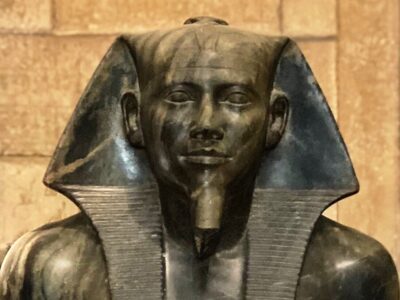
A statue of Pharaoh Khafre in Cairo’s Egyptian Museum
After taking a few photos of the pyramids from the panoramic overlook, Wally and I returned to the car (driver and subpar guide) we had hired for the day. They drove us a short distance to another parking lot within the pyramid complex outside of Khafre’s temple.
“Did Napoleon and his troops shoot off the nose of the Sphinx during target practice?
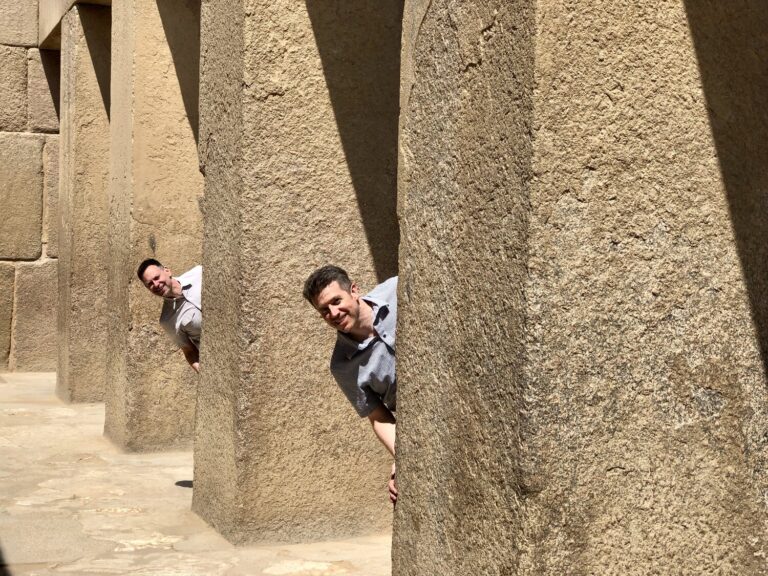
Duke and Wally peek out from the columns in the open-air Temple of Khafre
Like the Temple of Horus at Edfu, the structure remains well preserved, thanks to having been buried under sand until it was rediscovered and excavated by French archaeologist Auguste Mariette in 1853. A diorite statue of Khafre, an Old Kingdom pharaoh circa 2570 BCE, shows the ruler seated with the falcon symbolizing the god Horus behind his head. It was discovered by Mariette’s workmen in 1860, inside a pit within the temple. You can now see the statue amongst the many finds scattered about the Egyptian Museum in Cairo.

Duke in the temple, en route to the Sphinx
Inside the now-open-air temple lies a peristyle hall containing a series of monumental limestone blocks quarried from the bedrock surrounding the Sphinx. The walls, lintels and columned court are sheathed in pink granite stone brought 500 miles downriver from Aswan. It’s nothing short of amazing to know that we were walking inside a structure erected thousands of years ago.
As Wally and I wandered through, the previously mentioned guide, Ahmed, whom we booked through the Kempinski concierge — beware! — mentioned that the temple floors were fashioned from slabs of white-veined calcite. The temple ends at a narrow ascending passage leading up to an open doorway, making for a dramatic exit anf reveal of the Great Sphinx.

Whose head is that on the Sphinx, seen here in a 1790 illustration by Louis Francois Cassas?
THE SPHINX’S IDENTITY CRISIS
In Ancient Egypt, statuary and art was reserved for the ruling class and often served a political or religious function. The elite were the only ones who could afford to commission their likeness in stone, but it remains a mystery as to whose face the Great Sphinx of Giza was meant to represent. No inscriptions were left to confirm who erected it or when. However, Ahmed referred to the Sphinx as Khafre, and archaeological evidence has since indicated that it was constructed during Khafre’s reign, so I’d be willing to agree it was him.
The Great Sphinx is one of the oldest and largest monolithic statues in the world. Because nobody knows its original name, the Greeks referred to it as a sphinx — which to them was traditionally a bare-breasted woman with a lion’s body and eagle’s wings who kills those who cannot answer her riddle. Carved from a single deposit of limestone bedrock on the Giza plateau, the recumbent, mythological creature has the body of a lion and the head of a king, and most likely was intended to symbolize Khafre’s unification with the sun god Re (or Ra), who also acted as guardian of the Giza necropolis.
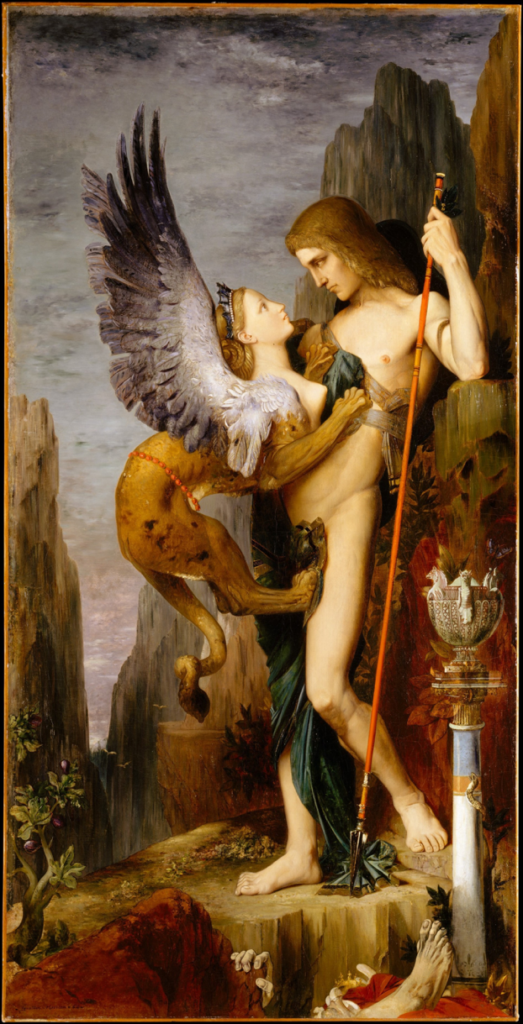
Oedipus and the Sphinx by Gustave Moreau, 1864. She doesn’t look too fierce — but notice the corpse at the bottom of the painting
Limestone is a soft sedimentary rock composed primarily of the compressed remains of marine organisms that died in the waters of ancient seas. Time has not been kind to the Sphinx, and due to variations in the density of the bedrock, its surface appears to undulate.
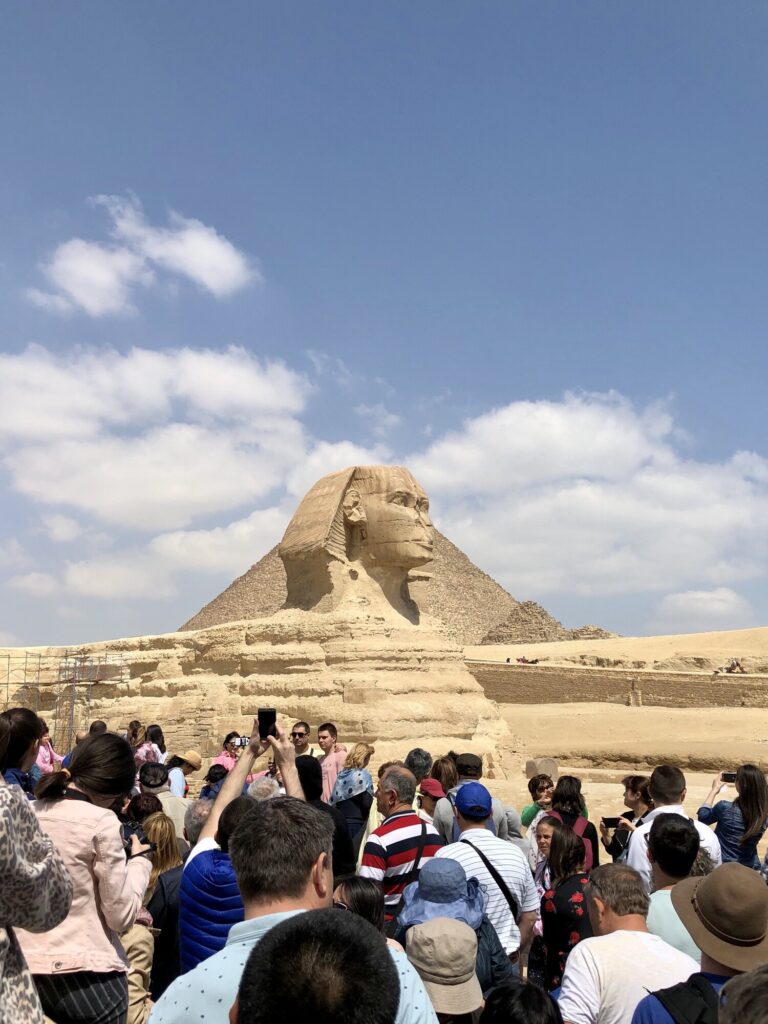
You can get a good shot of the Sphinx, but you’ll have to fight your way through the crowd
We were only allowed to walk within a narrow space to one side of the Sphinx and not around the monument as is often seen on so many television programs. It was crowded on that strip, and there were tourists taking selfies and other photos, which made viewing the Sphinx a letdown for us.
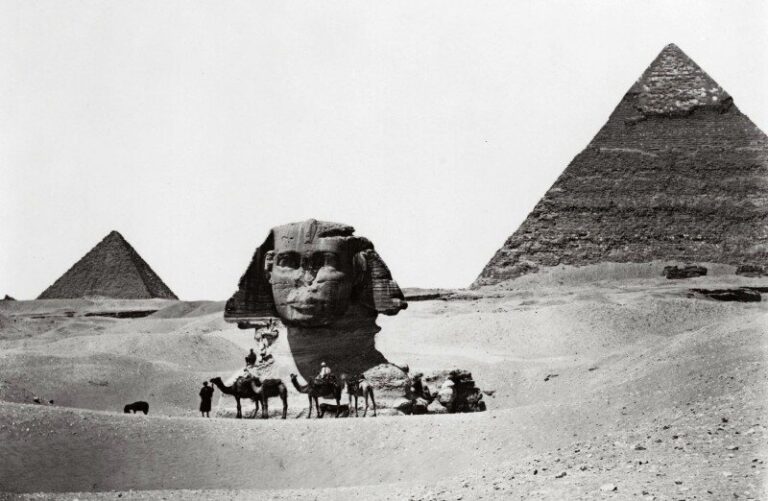
For centuries, only the head of the Sphinx peeked out from the desert, with the rest buried in the sand
DREAM STELE: WHEN DREAMS COME TRUE
The Great Sphinx was already ancient and abandoned by the time Prince Menkheperure discovered it on a hunting expedition. The colossal monument had been swallowed to its neck by the desert sands, and the prince decided it was as good a spot as any for a nap. He fell asleep beneath the shadow of its head. He later claimed that the Sphinx, in the embodiment of the sun god, Horemakhet, or Horus on the Horizon, appeared to him in a dream and made him a deal that the ambitious young royal couldn’t refuse: Although he wasn’t next in line, the Sphinx promised the prince the throne if he freed the great statue from the desert sands.
We don’t know what happened to his older brother, who was next in line, but Menkheperure did indeed become pharaoh, changing his name to Thutmose IV. To commemorate the event, he erected a small chapel between the front paws of the Great Sphinx. Inside the sacred chamber, Thutmose placed a 15-ton pink granite memorial slab inscribed with a telling of the so-called miracle. It’s also entirely possible that the stone table known as the Dream Stele was fabricated to legitimize Thutmose IV’s authority after usurping the throne.

British soldiers pose at the base of the still-buried and noseless Sphinx
SPHINX MYTH BUSTING: WHO NOSE?
The biggest myth perpetuated over time claims that Napoleon and his troops used the nose of the Sphinx for target practice and were responsible for this missing feature. European visitors to Egypt prior to Napoleon’s expedition had already discovered the vandalism to the Sphinx, and 18th century sketches of the beast indicate that the statue’s disfigurement occurred well before the French emperor was even born.
Another tale is that it was deliberately hacked off by a Sufi Muslim named Muhammad Sa’im al-Dahr, who was outraged by peasants making offerings to the colossal beast in hopes of controlling the flood cycle of the Nile, which would result in a successful harvest.
Though it’s now indistinct from the hue of its desert surroundings, Ahmed told us that the Sphinx was once elaborately painted. He gestured to the residue of original blue pigment that remains near the ear, but I couldn’t see it.

A historic illustration of the Sphinx. We wish we could climb a ladder onto its head!
After taking in the pyramids and Sphinx, Wally and I both needed to use the bathroom. Make sure to keep small bills for this purpose — the attendants will hand you a single square of toilet paper and ask for money before permitting you to go in.
Before using the restroom, Wally and I stood on the terrace of a café and took some great photos of the Sphinx, with the Pyramids in the background. This is where I suspect the nightly Sound and Light Show is held. If you want some pics here, take them quickly — a guard came right over to scold us. I thought it might be because the grounds outside the monument were strewn with garbage, and a photo would have cast it in a less-than-flattering light. Wally thought it was a privilege reserved for those who paid for a meal on the terrace overlook. I guess this will remain an unsolvable riddle for the time being.
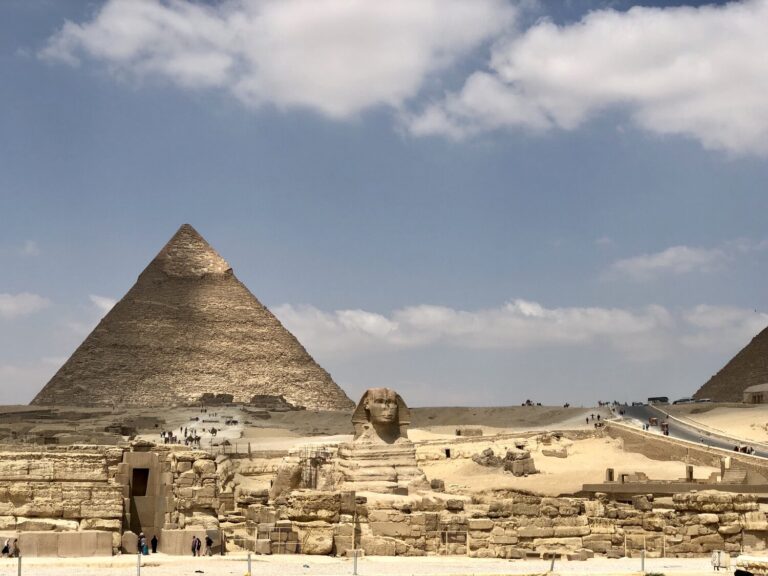
The nearby restaurant offers a front-on view of the Sphinx
Admission for the valley temple and Great Sphinx are included with the 160 Egyptian pound ticket to the Giza Plateau. –Duke
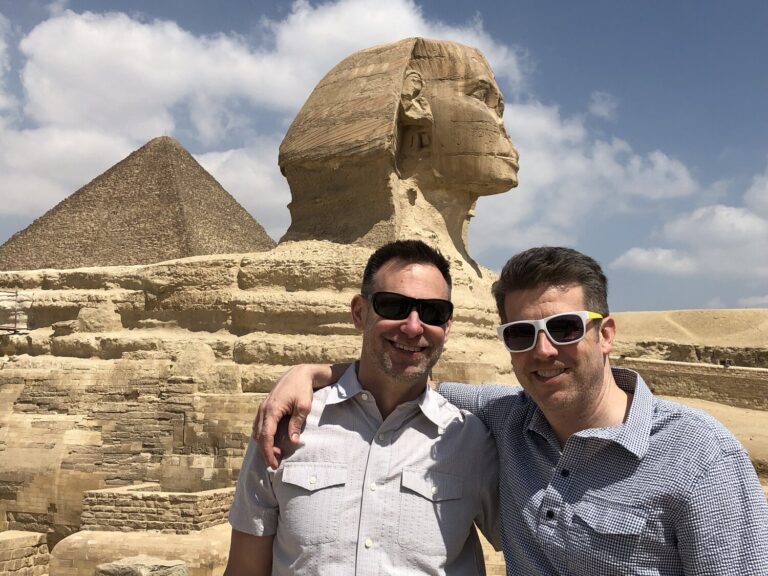
Duke and Wally were bummed they couldn’t get closer to the massive monument